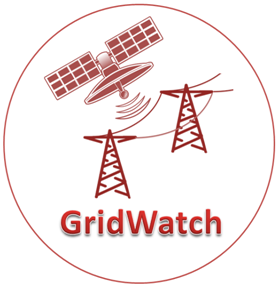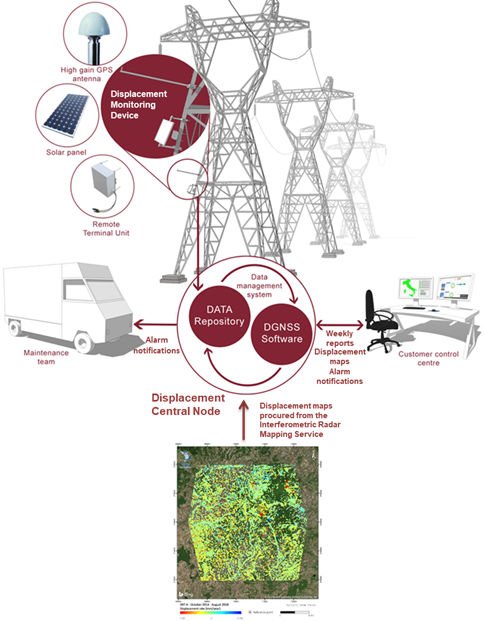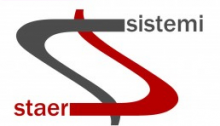
Objectives of the service
GridWatch addresses, by means of two specific solutions, key needs that owners of high voltage power infrastructures face:
- Maintenance of the power infrastructure;
- Network operations and energy dispatching.
Current procedures for power infrastructure maintenance involve periodic site inspections to assess the infrastructure condition and identify necessary maintenance interventions. Challenges include the impossibility to
- quickly detect sudden damages/anomalies;
- rapidly identify evolving problems, such as sliding, ice sleeves growth, etc.;
- promptly detect damaged towers;
- have on-demand damage assessment without scheduling extra-ordinary intervention.
The Integrity solution addresses these challenges with a monitoring and early alarming system that continuously monitors pylons’ conditions, providing alarms in case of damages, anomalies, or problems without performing site inspections.
The planning of energy dispatching along the power lines is traditionally made by limiting the amount of energy that can be dispatched based on conservative assumptions about ambient temperature, solar irradiance, wind speed and direction. This limitation creates difficulties in managing power line outages due to line overloading from critical dispatch operations or Renewable Energy Sources production peaks.
The Ampacity solution overcomes this conservative approach by providing continuously updated measurements of ambient temperature, wind speed and direction, solar irradiance and conductor temperature to calculate the actual value of the network capacity.
Users and their needs
Owners of high voltage power infrastructures, such as transmission system operators (TSOs) and distribution system operators (DSOs), are in charge of dispatching electrical energy from the power producers to the energy consumers, while keeping the energy network balanced between energy production and demand.
Two key tasks of these companies are the maintenance of the power infrastructure as well as the network operations and energy dispatching. Consultations with the Italian Transmission System Operator TERNA and other European operators (such as ELES – Slovenian TSO, UKPN – UK DSO) allowed to identify several needs:
For the maintenance of power infrastructure, key needs include:
- immediate detection and notification of damages, problems and anomalies occurred to the tower;
- identification, notification and constant monitoring of evolving problems, such as land sliding, ice sleeves growth, etc.;
- prompt detection and notification of damaged towers in case of power system failures;
- on-demand damage assessment without additional costs due to scheduling extra-ordinary interventions.
For network operations and energy dispatching, key needs include:
- Continuous measurement of the parameters necessary to assess the dynamic capacity of the power lines, such as ambient temperature, wind speed and direction, solar irradiance and conductor’s temperature.
The targeted markets are Italy and Europe.
Service/ system concept
GridWatch comprises Integrity and Ampacity solutions.
The Integrity solution targets the Maintenance and Inspection Departments, the information provided about status of the asset allows the customers to take informed decisions for reducing the maintenance cost, to redact “educated” recovery plans and to improve safety.
Integrity solution is composed of two subservices:
- Displacement Monitoring subservice, in charge of monitoring movements of the pylons due to land movements
- Structural Health Monitoring subservice, in charge of monitoring the integrity of the infrastructure such as mechanical soundness of the pylons and the ice build-up on the conductors.
The Displacement Monitoring subservice is composed of two elements:
- an Extended Monitoring element, based on satellite images and devoted to periodically monitoring of large areas and the pylons prone to sliding problems within the areas.
- a Punctual Monitoring element, based on the satellite navigation signal and devoted to 24/7 monitoring of the pylons more prone to sliding problems.
Below figure illustrates the product and service architecture.

The Structural Health Monitoring subservice is based on the analysis of the signal produced by piezoelectric sensors and devoted to 24/7 monitoring of the pylons’ integrity condition. Local devices, installed at the basis of the target towers, acquire and transmit sensors’ data via GPRS network and Internet Protocol (IP) to a software running on servers (cloud or on premises). The software performs the necessary analysis and displays the results to the final users/operators via a web application. Local devices are configured via SMS by the system installer.

The Ampacity solution addresses the network operations and energy dispatching by providing the continuously updated value of the network capacity (or, alternatively, the continuously updated measurements of the underlying parameters, such as ambient temperature, wind speed and direction, necessary to calculate the network capacity).
This information will help customers to estimate actual network capacity helping the exploitation of the unused capacity of existing power infrastructures.
The Ampacity solution consists of an Ampacity Kit composed of:
- a Weather Node installed at the monitored towers;
- a Conductor Node, installed on line segments.
Ampacity Kit includes specific sensors to measure parameters and a modem to transmit them a software running on server (cloud or on premises), which calculate the “real-time” ampacity.
Such “real-time” ampacity is complemented by calculation of the predicted ampacity, obtained by processing weather forecast data and activated on customer request.

Space Added Value
GridWatch exploits the following space assets:
- Synthetic Aperture Radar images (Medium and High Resolution, from both COSMO-SkyMed and Sentinel-1 satellites) of areas subjected to landslides and slow movements are collected and processed using interferometry techniques to periodically monitor pylons’ displacements within these areas. This process allows to identify and to monitor, once or twice per year, the pylons displacements within these areas.
- Satellite Navigation is used in combination with Synthetic Aperture Radar images, in particular to assess the displacement of pylons more prone to sliding phenomena in the areas monitored with Synthetic Aperture Radar images. With satellite navigation receivers installed on pylons, the system can continuously and remotely monitor the pylons’ displacements with respect to an initial reference position, filling the gap between traditional ground inspections.
Weather data are used to support the energy dispatching service with information about the current environmental conditions. In conjunction with local sensors for specific areas, this information can be used to estimate the current capacities of the overhead lines.
Current Status
The GridWatch Demonstration Project successfully demonstrated three elements:
- The monitoring of pylons in area subjected to sliding phenomena, by means of both SAR images and displacement monitoring devices;
- The monitoring of structural integrity of pylons (including monitoring of ice sleeves formation around conductors) by means of structural health monitoring devices equipped with piezoelectric sensors;
- The monitoring of the ambient parameters and conductor temperature, by means of local devices (named Ampacity Kit).
During the Demonstration Project, the consortium also achieved preliminary sales, not only to the user involved in the Demo Project, but also to an important Italian distribution system operator. Further discussions with interested potential customers are ongoing.



